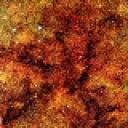 At 9am the the IKIRT Infrared Deep Sky Survey (UKIDSS) was released to the world. This survey was started in 2005 when the world’s largest and most sensitive IR instrument was commissioned on IKIRT. It is able to survey the sky faster and deeper than anything else. Hubble Deep Field , move over, there is a new kid in town.
At 9am the the IKIRT Infrared Deep Sky Survey (UKIDSS) was released to the world. This survey was started in 2005 when the world’s largest and most sensitive IR instrument was commissioned on IKIRT. It is able to survey the sky faster and deeper than anything else. Hubble Deep Field , move over, there is a new kid in town.
But the question is: why should such a powerful instrument dedicate its life to exploring the sky and just letting all its data hang out online, free of charge and free for anyone to use?
Where to start…
Data surveys like UKIDSS allow multiple astronomers (and teams of astronomers) to explore multiple questions on the same data set at the same time freely and easily. With infrared data, we are able to peer through the dust and gas of the plane of the Milky Way and see millions of stars, galaxies 100,000,000,000 (10^11) galaxies beyond the stars, and structures that are otherwise completely obscured. This opens up areas of science and volumes of space that can’t be seen with any optical telescope.
Infrared is a powerful color of light to use for observations. This color of light isn’t scattered by dust, but it instead easily passes through this intervening gunk to reach us from distant objects. Observing infrared is hard because you have to eliminate all heat sources in and near your detector that could be generating infrared light. Liquid helium is used in large quantities to keep everything dark. In IR, body heat is a form of light pollution ! (So stay out of the dome).
Using this survey, astronomers from different teams can look out through the disk of the galaxy and simultaneously study the distribution of stars (and thus the detailed structure of the plane), and the distribution of the galaxies beyond (and thus the detailed structure of the universe). These groups can be studying the same places on the sky, using different objects that appear side-by-side in their images, and answering different and meaningful questions with their work. (And the stars people were curse the galaxies for being in the way and the galaxies folks will curse the stars for the same reason).
With surveys, astronomers can sit in their office, have a “I want to know _______” moment, and answer the question using survey data without having to spend the time writing telescope proposals, waiting for telescope time, and then spending time reducing the data from raw images and calibration frames to final images. Instead, they login, download, and (after several weeks or months of analysis) just answer their questions. In a world of big questions, and limited numbers of big telescopes, surveys are the great equalizer that allow the tech savvy scientist to effectively glean all the data they want from open data pools.
I already have a couple ideas for things I want to do…
Want to play? UKDSS is located here. Check out their gallery of fabulous images. (Little one of the core of the Milky Way included above)



Trackbacks/Pingbacks